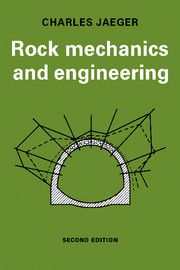Book contents
- Frontmatter
- Contents
- Preface
- Preface to the first edition
- Part 1 Introduction to rock mechanics
- Part 2 Rock material and rock masses
- Part 3 Rock mechanics and engineering
- Part 4 Case histories
- References
- Appendix 1 Comments on the bibliography
- Appendix 2 Measurement conversion tables
- Appendix 3 Table of geological formations and earth history
- Appendix 4 Some petrographic properties of rocks
- Author Index
- Index of geographical names, dam sites, reservoirs, tunnels and caverns
- Subject Index
Preface to the first edition
Published online by Cambridge University Press: 04 August 2010
- Frontmatter
- Contents
- Preface
- Preface to the first edition
- Part 1 Introduction to rock mechanics
- Part 2 Rock material and rock masses
- Part 3 Rock mechanics and engineering
- Part 4 Case histories
- References
- Appendix 1 Comments on the bibliography
- Appendix 2 Measurement conversion tables
- Appendix 3 Table of geological formations and earth history
- Appendix 4 Some petrographic properties of rocks
- Author Index
- Index of geographical names, dam sites, reservoirs, tunnels and caverns
- Subject Index
Summary
The first attempts at investigating the mechanical and physical properties of rocks go back to the second half of the last century; but systematic efforts to develop this into a real science of rocks are recent.
One of the more important results of these efforts has been to show the paramount importance of voids, fissures and faults at the level of rock crystals or grains of the rock material and of large masses of rocks in situ. Any theory of rock mechanics which considers rocks to be no more than homogeneous masses is just a first approximation. All the properties of rock and rock constants: strength, elasticity, plasticity, perviousness and reactions to sound and to seismic waves depend on the gaps, voids or fissures of the rock as much as on the skeleton of the solid material which builds it up. It is from this point of view that this book has been written.
One of the main purposes of the book is to stress the many links between rock mechanics and engineering. Mining engineers and civil engineers cannot excavate mines or build structures without a knowledge of rock mechanics. This is now accepted by these professions, which include discussions on rock mechanics at their international congresses and symposia. On the other hand, the benefit that rock mechanics gets from the development of modern engineering techniques has seldom been adequately appreciated.
- Type
- Chapter
- Information
- Rock Mechanics and Engineering , pp. xi - xiiPublisher: Cambridge University PressPrint publication year: 1979



